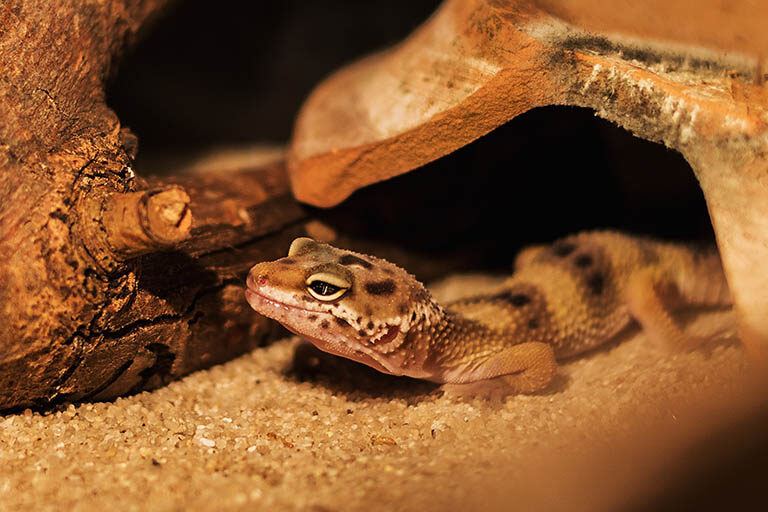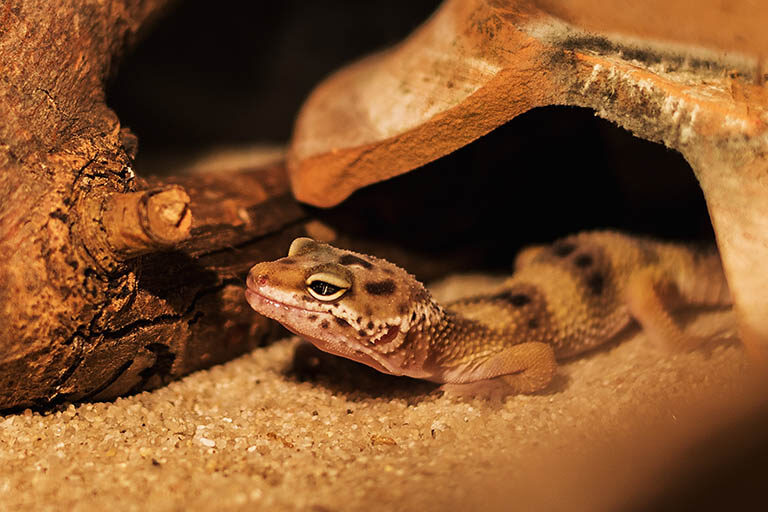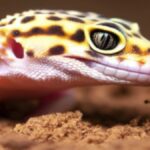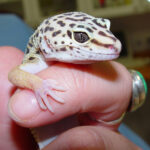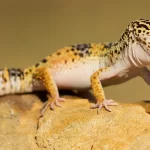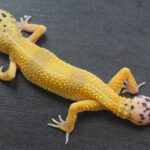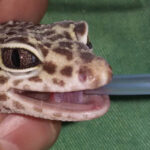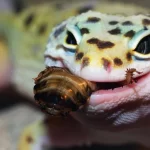The photoperiod is the time a Leopard gecko is exposed to light over a period of 24 hours. The Leopard gecko photoperiod affects behaviour and reproduction.
Introduction Leopard gecko photoperiod
The photoperiod is the period of time (in hours and minutes) per day during which we are exposed to light. In other words, daytime (vs. night time). On earth, natural light mainly comes from the sun. The number of daylight hours varies from place to place. It is mainly dependant on the location on earth and typically ranges between 10 and 14 hours per day.
For reptiles, the photoperiod establishes a day-night rhythm which does not only affect their day to day activity and behaviour but also their ability to determine the season of the year. It is known that Leopard geckos are crepuscular(50)(51)(59) to nocturnal(49)(69) by nature, meaning they are intermittently active during the periods of dusk, dawn and the evenings.
Outside these periods (i.e. during the day and during the night), Leopard geckos will spend most of their time hiding and sleeping. Because of this, it is commonly concluded that they do not need exposure to light at all, but various literature suggests that it is not the case and that even pet Leopard geckos do benefit from having day and night patterns.
Scientists are also of the opinion that irregular photoperiods and excessive periods of darkness are actual stressors of Leopard geckos(29)(30).
In most cases, using the natural day-night patterns of your location will be enough. For those not living in sunny areas and/or in the case where electrical light sources are used, the photoperiod for Leopard geckos can either be set to 12 hours per day or between 11 hours in winter and 13 hours in summer.
Leopard geckos are believed to show sensitivity to the photoperiod — called photoperiodisms. They are also sensitive to what time of day it is. In this photo, a juvenile Leopard gecko is hiding under shelter. This is typically done by Lepard geckos during the day and/or during the night.
The phenomenon of being sensitive to the photoperiod is called photoperiodism. Although the photoperiod is defined by the length of day or a light period, photoperiodism is the physiological reaction of organisms to the length of the night or a dark period.
Scientists believe that the amount of melatonin (see later) varies when there is a variation in the photoperiod — which suggest that photoperiod might have an effect on their biology, reproduction and other behaviours. When a Leopard gecko is placed in an artificial environment, the photoperiod needs to be considered as it will likely affect the behaviour and reproduction.
Natural photoperiod for Leopard geckos
As mentioned earlier, the number of daylight hours depends on where you are in the world. When looking at the day-night rhythms of South Asia (where Leopard geckos are naturally found) there is a relatively small difference between seasonal photoperiods. Starting to increase after winter, daylengths are at their longest in June (about 12 hours and 50 minutes).
The shortest days are in December and January (11 hours and 30 minutes). This gives about 11 hours and 10 minutes of nighttime during summer and 12 hours and 30 minutes during winter. During autumn and spring, the daylight length will gradually change towards or away from about 13 hours per day.
Also see
Natural distribution and habitat of Leopard geckos
The brain of many lizards has an area that is called the pineal complex. This area consists mainly of the pineal gland (also referred to as the pineal body or the pineal organ) and the pineal eye (also referred to as the parietal eye or a ‘third eye‘). Both the pineal gland and the parietal eye are photosensitive(52) (i.e. sensitive to light).
Note: Although the author of this article could not find any direct reference on whether (both) these areas are present in Leopard geckos, both are cited to be present in Squamata (which includes Leopard geckos) and the pineal eye is cited to be present in some Squamata(52).
The pineal gland should not be confused with the Jacobson’s organ (which is the part of the brain which is used to ‘smell’).
Although some of their functions are still unknown, the pineal gland, and, to a lesser degree, the parietal eye mainly secretes the hormone melatonin. Research showed that there seems to be an inverse relationship between cultured melatonin levels and environmental light(52).
In other words, more melatonin is secreted in the absence of light. Interestingly enough, its secretion was reduced in the presence of white light, but not in infrared light(52).
Reptiles are known to exhibit daily and yearly patterns in their behaviour. A rhythmic pattern that repeats every 24 hours is called a circadian rhythm. In reptiles, melatonin is believed to play a vital role in maintaining this circadian rhythm(52). Taking the seasonal differences of photoperiod into consideration, one can appreciate the fact that the average melatonin levels with differ between summer and winter months.
For this reason, and others, it is believed that melatonin plays a functional role in many aspects of reptilian biology(52). Melatonin has an influence on the behavioural and physiological mechanisms controlling thermoregulation(52)(53). The pineal complex is suspected to also be involved in the reproduction cycles and behaviour of reptiles(52).
Also see
Breeding behaviour in Leopard geckos
Leopard gecko breeding
Photoperiod for pet Leopard geckos
Even though there is a seasonal variation of the photoperiod in nature, the well-being and breeding patterns of pet Leopard geckos do not seem to differ significantly in the absence of small daylight variations. This is probably due to the fact that temperature also plays a role. Most Leopard gecko keepers prefer to use natural room light or 12 hours(50) of artificial light.
Artificial light is usually supplied by using overhead lighting in the form of fluorescent tubes, energy saver light bulbs, LEDs or low power (

